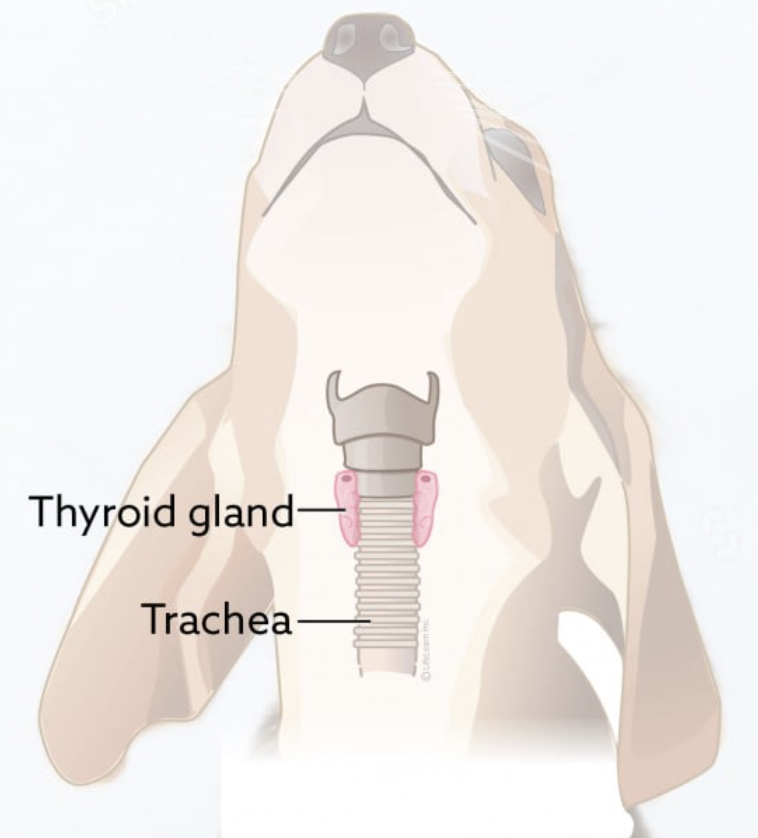Hypothyroidism
Hypothyroidism is the most common hormonal imbalance in dogs and is also very common in people. Thyroid hormone (nicknamed T3) sets the body’s metabolic rate, sort of like a volume dial. T3 determines how hard or how fast each cell works to do its job. Every cell of the body is affected by T3. When there is a deficiency of the thyroid hormones, the individual experiences a metabolic "slow down". Because of the importance of thyroid hormone in metabolism, many organ systems can be affected and multiple symptoms are described. Diagnostic tests can be just as confusing as the symptoms but at least the treatment is relatively straightforward.
We bring up these terms: T3, T4, TSH, and free T4 because these are the substances that will be tested when it comes time to run diagnostics. Every cell in the body is affected by it. Too much hormone and the heart races, blood pressure rises, and muscle and fat are burned until the patient becomes skinny and debilitated. Too little hormone and the patient becomes listless, overweight, and even bald in spots. Hypothyroidism is the medical condition where the body is deficient in thyroid hormone.
What is the Thyroid Gland and What Does it do?
The thyroid gland is located in the neck area near the trachea. The thyroid gland produces T4, which is an inactive form of thyroid hormone. When T4 is absorbed into tissue cells, it is converted into the active form of thyroid hormone that is called T3. Production of T4 is regulated by the pituitary gland at the base of one’s brain. The pituitary produces a substance called thyroid stimulating hormone (TSH). When T4 levels are dropping, the pituitary gland stimulates the thyroid gland to make and release more T4.
Thyroid hormone regulate the body’s metabolic rate. Since virtually every cell in the body can be affected by reduced levels of thyroid hormone, it is not surprising that reduced levels of thyroid hormone lead to symptoms in multiple body systems.
Manifestations of Hypothyroidism
Hypothyroidism is the natural deficiency of thyroid hormone. This deficiency is most commonly caused by immune-mediated destruction of the thyroid gland. In other words, the individuals immune system destroys the thyroid gland.
Hypothyroidism generally develops in middle aged or elderly dogs, with the average age at diagnosis being 7 years. Breeds with definite predisposition to develop hypothyroidism include the Doberman pinscher, the Golden retriever, the Irish Setter, the Great Dane, the Dachshund, and the Boxer.
Clinical signs
Skin abnormalities including dark pigmentation and being more prone to skin infections. Skin often appears oily and smelly.
Hair loss (often this starts on the tail leading to a rat tail appearance or a bald area around the collar). Dry, dull, brittle hair with excessive shedding.
Weight gain
Lethargic and listless
Cold intolerance
Slow heart rate
High cholesterol levels and aneamia
Diagnosis
The most common screening test is a total thyroxin (TT4) level. This is a measurement of the main thyroid hormone in a blood sample. A low level of total thyroxin, along with the presence of clinical signs is suggestive of hypothyroidism. Definitive diagnosis is then made by performing a free T4 by equilibrium dialysis (free T4 by ED) or a thyroid panel that assesses the levels of multiple forms of thyroxin. If this test is low, then your dog has hypothyroidism.
Testing with a Trial of Medication
Sometimes the only way to test for hypothyroidism is to simply give the medication for several months and see what happens. Often an improvement in attitude and energy level is seen within the first week. Hair re-growth takes substantially longer (typically 4 months minimum) as the follicles must reawaken and then grow a hair long enough to be seen.
Is the Diagnosis Correct?
Because of difficulties in diagnostic testing methods many dogs have been erroneously diagnosed with hypothyroidism and have been on medication for years. If there is any question about a patient and you wish to re-test, thyroid hormone supplementation must be discontinued at least 2 months for blood testing to be valid.
Treatment
Treatment of hypothyroidism is relatively straight forward; hypothyroidism is treated with oral administration of thyroid hormone (T4). Pills are given usually twice daily to start but may be dropped to once a day after good thyroid control has been achieved.
Treatment is given for the rest of the dog's life.
Monitoring
Whenever an animal goes on a medication long term, periodic blood testing is a good idea. In the case of hypothyroidism treatment, it is important to know if the medication dose is too low or too high. Thyroxine (T4) is a safe medication but if it is not given in adequate doses, obviously the patient will not be adequately treated. If the dose is too high and given for too long a time, excessive water consumption, weight loss, and restlessness can result.


